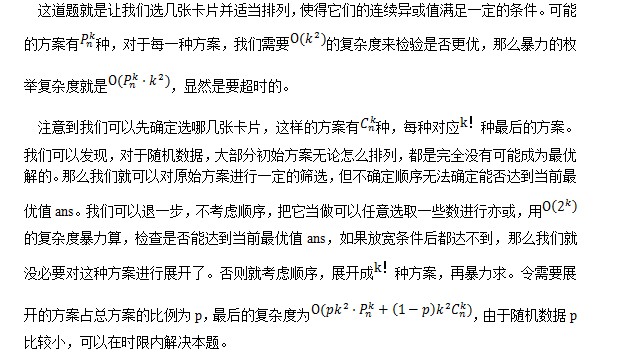本文主要是介绍LeetCode1423. Maximum Points You Can Obtain from Cards,希望对大家解决编程问题提供一定的参考价值,需要的开发者们随着小编来一起学习吧!
文章目录
- 一、题目
- 二、题解
一、题目
There are several cards arranged in a row, and each card has an associated number of points. The points are given in the integer array cardPoints.
In one step, you can take one card from the beginning or from the end of the row. You have to take exactly k cards.
Your score is the sum of the points of the cards you have taken.
Given the integer array cardPoints and the integer k, return the maximum score you can obtain.
Example 1:
Input: cardPoints = [1,2,3,4,5,6,1], k = 3
Output: 12
Explanation: After the first step, your score will always be 1. However, choosing the rightmost card first will maximize your total score. The optimal strategy is to take the three cards on the right, giving a final score of 1 + 6 + 5 = 12.
Example 2:
Input: cardPoints = [2,2,2], k = 2
Output: 4
Explanation: Regardless of which two cards you take, your score will always be 4.
Example 3:
Input: cardPoints = [9,7,7,9,7,7,9], k = 7
Output: 55
Explanation: You have to take all the cards. Your score is the sum of points of all cards.
Constraints:
1 <= cardPoints.length <= 105
1 <= cardPoints[i] <= 104
1 <= k <= cardPoints.length
二、题解
从前或后取k个元素和最大,转换为剩余n-k个连续窗口的元素和最小。利用滑动窗口求解。
注意accumulate函数,cardPoints[i] - cardPoints[i-windowSize]的写法。
class Solution {
public:int maxScore(vector<int>& cardPoints, int k) {int n = cardPoints.size();int windowSize = n - k;int totalSum = accumulate(cardPoints.begin(),cardPoints.end(),0);int sum = accumulate(cardPoints.begin(),cardPoints.begin()+windowSize,0);int minSum = sum;for(int i = windowSize;i < n;i++){sum += cardPoints[i] - cardPoints[i-windowSize];minSum = min(minSum,sum);}return totalSum - minSum;}
};
这篇关于LeetCode1423. Maximum Points You Can Obtain from Cards的文章就介绍到这儿,希望我们推荐的文章对编程师们有所帮助!






